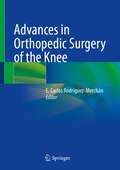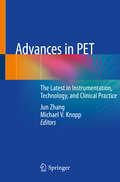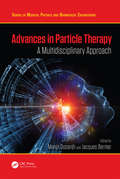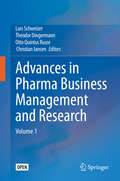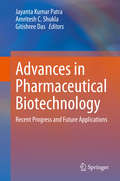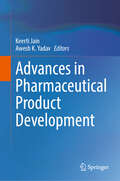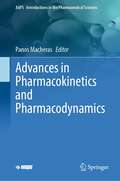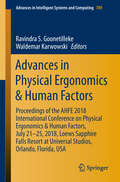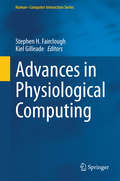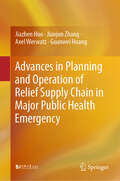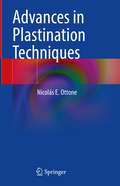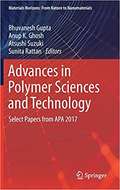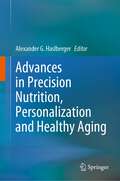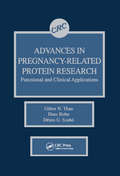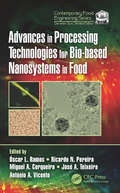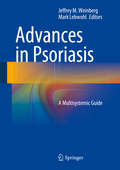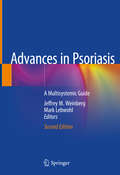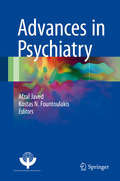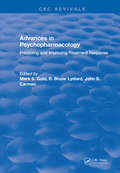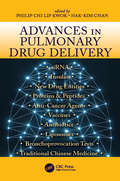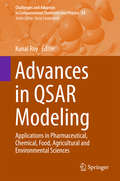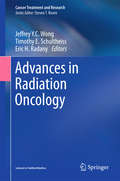- Table View
- List View
Advances in Orthopedic Surgery of the Knee
by E. Carlos Rodríguez-MerchánThis book reviews current state-of-the-art knowledge on knee surgery, covering all relevant topics, ranging from meniscus repair and anterior cruciate ligament reconstruction to total knee arthroplasty. Although many of the interventions to treat meniscal, anterior cruciate ligament, patellofemoral osteoarthritis and femorotibial osteoarthritis are globally accepted, there are still many controversies as to which one is the most appropriate for each injury. Written by orthopedic surgeons from leading institutions specialized in the treatment of knee injuries, this volume critically discusses and sheds new light on these controversies.
Advances in PET: The Latest in Instrumentation, Technology, and Clinical Practice
by Jun Zhang Michael V. KnoppThis book is a guide to new and emerging PET technology, instrumentation, and its place in clinical practice. PET technology is currently moving from the conventional photomultiplier tube (PMT) detector based PET to the new generation, solid state light sensor detector. This is a technological leap and holds significant implications for the use of PET imaging. This book introduces and describes the emerging and new generation of PET instrumentations and technologies across manufactures, focusing on solid-state PET detector designs, system characteristics, and clinical practices as well as future advanced Time-of-Flight (TOF) PET technologies. Organized into three sections, the basics of PET imaging; solid state digital PET instrumentation, technology, and clinical practice; and a look to the future of PET imaging, chapters present a full picture of PET imaging, where we are and where we will be. Nuclear medicine physicians, physicists, and technologists can use this book to better understand future PET systems, novel PET technologies, and potential game changes of clinical PET practice.
Advances in Particle Therapy: A Multidisciplinary Approach (Series in Medical Physics and Biomedical Engineering)
by Jacques Bernier Manjit DosanjhHadron therapy is a groundbreaking new method of treating cancer. Boasting greater precision than other therapies, this therapy is now utilised in many clinical settings and the field is growing. More than 50 medical facilities currently perform (or are planned to perform) this treatment, with this number set to double by 2020. This new text covers the most recent advances in hadron therapy, exploring the physics, technology, biology, diagnosis, clinical applications, and economics behind the therapy. Providing essential and up-to-date information on recent developments in the field, this book will be of interest to current and aspiring specialists from a wide range of backgrounds. Features: Multidisciplinary approach: explores the physics, IT (big data), biology, clinical applications from imaging to treatment, clinical trials, and economics associated with hadron therapy Contains the latest research and developments in this rapidly evolving field, and integrates them into the current global challenges for radiation therapy Edited by recognised leaders in the field, including the co-ordinator of ENLIGHT (the European Network for Light Ion Hadron Therapy), with chapter contributions from international leading experts in the field
Advances in Periodontal Surgery: A Clinical Guide to Techniques and Interdisciplinary Approaches
by Salvador NaresThis book describes practical, contemporary, and evidence-based surgical approaches for the treatment of diseases and conditions affecting the periodontium, including advanced forms of periodontal disease, gingival recession, and complex cases requiring interdisciplinary management. The book opens by identifying key considerations in periodontal surgery, for example with regard to diagnosis and prognosis, and by presenting decision trees that will be useful in daily practice. Cutting-edge resection and regeneration techniques for the treatment of periodontitis and mucogingival surgical procedures for the management of soft tissue deficiencies are then described and illustrated in detail, highlighting important tips and tricks as well as potential difficulties and complications. The final part of the book is devoted to interdisciplinary care, which is of key importance when periodontal surgery is indicated in the management of cases requiring orthodontic, endodontic, and restorative therapy. Advances in Periodontal Surgery will be of value for practitioners at all levels of experience as well as for students entering the field.
Advances in Pharma Business Management and Research: Volume 1
by Lars Schweizer Theodor Dingermann Otto Quintus Russe Christian JansenThis open access book presents a unique collection of practical examples from the field of pharma business management and research. It covers a wide range of topics such as: 'Brexit and its Impact on pharmaceutical Law - Implications for Global Pharma Companies', 'Implementation of Measures and Sustainable Actions to Improve Employee's Engagement', 'Global Medical Clinical and Regulatory Affairs (GMCRA)', and 'A Quality Management System for R&D Project and Portfolio Management in a Pharmaceutical Company'. The chapters are summaries of master’s theses by "high potential" Pharma MBA students from the Goethe Business School, Frankfurt/Main, Germany, with 8-10 years of work experience and are based on scientific know-how and real-world experience. The authors applied their interdisciplinary knowledge gained in 22 months of studies in the MBA program to selected practical themes drawn from their daily business.
Advances in Pharmaceutical Biotechnology: Recent Progress and Future Applications
by Jayanta Kumar Patra Gitishree Das Amritesh C. ShuklaThis book explains both the basic science and the applications of biotechnology-derived pharmaceuticals, with special emphasis on their clinical uses. The foundations of pharmaceutical biotechnology lie mainly in the capability of plants, microorganism, and animals to produce low and high molecular weight compounds useful as therapeutics. Pharmaceutical biotechnology has flourished since the advent of recombinant DNA technology and metabolic engineering, supported by the well-developed bioprocess technology. A large number of monoclonal antibodies and therapeutic proteins have been approved, delivering meaningful contributions to patients’ lives, and the techniques of biotechnology are also a driving force in modern drug discovery. Due to this rapid growth in the importance of biopharmaceuticals and the techniques of biotechnologies to modern medicine and the life sciences, the field of pharmaceutical biotechnology has become an increasingly important component in the education of pharmacists and pharmaceutical scientists. This book will serve as a complete one-stop source on the subject for undergraduate and graduate pharmacists, pharmaceutical science students, and pharmaceutical scientists in industry and academia.
Advances in Pharmaceutical Product Development
by Keerti Jain Awesh K. YadavThis book discusses the stages involved in pharmaceutical product development including the importance, requirement, and effect of each stage and process. It also covers prototype development for pharmaceutical formulations, scale-up studies, optimization, testing, packaging, and commercialization of different dosage forms for pharmaceutical products like tablets, suspensions, emulsions, coating, inhalational products, sterile products, and herbal formulations. The book also presents advancements in tablet production and tablet coating, including materials, material handling, granulation and granulation technologies, process automation, processing problems in tablet production and troubleshooting, advances in equipment for coating and coating materials. Further, the chapter explores the advances in the formulation and development of aerosols, nebulizers, inhalers, metered Dose Inhalers (MDI), and dry powder Inhalers (DPIs). Towards the end, the book examines the challenges, formulation development, testing, stability, and regulatory guidelines in the development of herbal formulations. This book provides a valuable source of information for the researcher, scientists, students, and people working in the area mainly focused on the challenges in pharmaceutical product development.
Advances in Pharmacokinetics and Pharmacodynamics (AAPS Introductions in the Pharmaceutical Sciences #9)
by Panos MacherasThis book provides a concise overview of recent advances in Pharmacokinetics (PK) and Pharmacodynamics (PD). The pharmacokinetics section covers the state of the art in Physiologically Based Pharmacokinetic (PBPK) modeling (Chapter 1) as well as the assessment of food effect on drug absorption using PBPK modeling (Chapter 2). Chapters 3 and 4 describe the recent development of Physiologically Based Finite Time Pharmacokinetic (PBFTPK) models and their applications to pharmacokinetic data. The pharmacodynamics section focuses on PK/PD modeling. Chapter 5 provides an overview of PK/PD modeling and simulation in clinical practice and studies. Chapter 6 deals with the subject/physiology variability issue encountered in PK/PD studies, while Chapter 7 reviews the influence of clinical pharmacology in the modernization of drug development and regulation. This book is an essential reference for pharmaceutical scientists.
Advances in Physical Ergonomics & Human Factors: Proceedings of the AHFE 2018 International Conference on Physical Ergonomics & Human Factors, July 21-25, 2018, Loews Sapphire Falls Resort at Universal Studios, Orlando, Florida, USA (Advances in Intelligent Systems and Computing #789)
by Waldemar Karwowski Ravindra S. GoonetillekeThis book reports on the state of the art in physical ergonomics and addresses the design of products, processes, services, and work systems to ensure they are productive, safe, and enjoyable for people to use. The human body’s responses to physical and physiological work demands, strain injuries from repetition, vibration, force, and posture are the most common types of issues examined, along with their design implications. The book explores a wide range of topics in physical ergonomics, including the consequences of repetitive motion, materials handling, workplace safety, the usability of portable devices, design, working postures, and the work environment. Mastering physical ergonomics and safety engineering concepts is fundamental to creating products and systems that people can safely and conveniently use, as well as avoiding stresses and minimizing the risk of accidents. Based on the AHFE 2018 Conference on Physical Ergonomics and Human Factors, held on July 21–25, 2018, in Orlando, Florida, USA, this book provides readers with a comprehensive perspective on the current challenges in physical ergonomics, which is a critical aspect in the design of any human-centered technological system, and for factors influencing human performance.
Advances in Physical, Social & Occupational Ergonomics: Proceedings of the AHFE 2021 Virtual Conferences on Physical Ergonomics and Human Factors, Social & Occupational Ergonomics, and Cross-Cultural Decision Making, July 25-29, 2021, USA (Lecture Notes in Networks and Systems #273)
by Waldemar Karwowski Ravindra S. Goonetilleke Atsuo Murata Shuping Xiong Henrijs Kalkis Zenija RojaThis book reports on cutting-edge findings and developments in physical, social and occupational ergonomics. It covers a broad spectrum of studies and evaluation procedures concerning physical and mental workload, work posture and ergonomic risk. Further, it reports on significant advances in the design of services and systems, including those addressing special populations, for purposes such as health, safety and education, and discusses solutions for a better and safer integration of humans, automated systems and digital technologies. The book also analyzes the impact of culture on people’s cognition and behavior, providing readers with timely insights into theories on cross-cultural decision-making, and their diverse applications for a number of purposes in businesses and societies. Based on the AHFE 2021 conferences on Physical Ergonomics and Human Factors, Social & Occupational Ergonomics, and Cross-Cultural Decision Making, held virtually on 25–29 July, 2021, from USA, it provides readers with a comprehensive overview of the current challenges in physical, social and occupational ergonomics, including those imposed by technological developments, highlights key connections between them, and puts forward optimization strategies for sociotechnical systems, including their organizational structures, policies and processes.
Advances in Physiological Computing (Human–Computer Interaction Series)
by Stephen H. Fairclough Kiel GilleadeThis edited collection will provide an overview of the field of physiological computing, i. e. the use of physiological signals as input for computer control. It will cover a breadth of current research, from brain-computer interfaces to telemedicine.
Advances in Planning and Operation of Relief Supply Chain in Major Public Health Emergency
by Jianjun Zhang Jiazhen Huo Axel Werwatz Guanwei HuangWith Operations Research and System Dynamics as research tools, this book discusses the theme of emergency supplies in Major Public Health Emergency (MPHE) scenarios. The subject includes a series of new issues: critical criteria matching supply with demand for emergency supplies in MPHE, emergency medical materials reserve mode, dynamic optimization of emergency logistics, dynamic optimization of allocating multi-period and multi-category emergency supplies, etc. This book is suitable for university teachers, undergraduate and graduate students, and researchers in fields of logistics and supply chain management as well as emergency management. The most important features of this book include: Firstly, to achieve fairness and accuracy of material distribution during the epidemic, this book constructs a material shortage adjustment function. Secondly, from the comprehensive perspective of cross-regional coordination, multi-organization coordination and multiperiod coordination, the operation optimization models of emergency material supply in major epidemic situation are constructed. Additionally, the comparative analysis and empirical research of the practices in China and Germany also reflects the novelty and benefit of the book.
Advances in Plastination Techniques
by Nicolás E. OttonePlastination is currently considered one of the most innovative forms of conservation of complete bodies, sections and organs, both human and animal, for use in undergraduate and postgraduate teaching, as well as morphological research. In this sense, to develop the various plastination techniques, specific equipment and specialized training of academics are required, who have the ability to carry out the diversity of protocols that exist, depending on the anatomical material to be preserved. The decomposition of organic matter is a vital process in nature, but it is also an impediment to morphological studies and research. This is particularly important in biological specimens that shrink considerably when exposed to normal atmospheric conditions. For this reason, it has always been a constantly pursued objective for anatomists. Plastination, in this regard, is a true alternative in the conservation of perishable biological tissues (complete bodies, complete organs such as brains, livers, lungs, kidneys, hearts, muscles, joint preparations, cuts in sections of complete corpses) - or from isolated regions, etc.) reaching a dry and imperishable state through the use of different polymers and special plastics, ensuring that the organs, limbs and entire bodies do not lose their texture and apparently normal disposition. This original book describes in detail and in an updated way the plastination techniques for the conservation of human and animal biological material, demonstrating the applications in teaching and research of anatomy, morphological sciences and health sciences. The didactic chapters present the history and the fundamentals of plastination techniques (steps, equipment, supplies, material, temperature), as well as its clinical, surgical and research applications. The work also features biosafety issues and provides Ethical Considerations in Plastination. Advances in Plastination Techniques is intended for a cross-section of academics, technicians and advanced students from all areas of Health Sciences - including Physicians and Dentists - and Veterinary Sciences.
Advances in Polymer Sciences and Technology: Select Papers from APA 2017 (Materials Horizons: From Nature to Nanomaterials)
by Anup K. Ghosh Sunita Rattan Bhuvanesh Gupta Atsushi SuzukiThis book presents select papers presented at the annual meeting of the Asian Polymer Association. The chapters in this volume document and report on a wide range of significant recent results for various applications, as well as scientific developments in the areas of polymer science and engineering. The chapters include original research from all areas of polymer science and technology with a focus on the manufacture, processing, analysis and application of long chain polymer molecules. This book will be of interest to researchers in academia and industry alike.
Advances in Precision Nutrition, Personalization and Healthy Aging
by Alexander G. HaslbergerThis book provides an overview on current trends and developments in precision nutrition and personalized health preservation, focussing on a field which is undergoing rapid change. Today, personalized strategies contrast generally accepted guidelines for specified groups and improved health and disease markers are shifting health care toward preventive strategies. At the same time, advances in food additives, nutraceuticals, functional, and medical foods are breaking down the traditional domains of health-related disciplines. This book aims to provide an overview on these processes, discusses arising problems, and provides an outlook on the future of personalized health care and the role of precision nutrition. It covers preliminary thoughts on what has been achieved and focusses on developments in the area of metabolic diseases, aging, and neurology. The book is intended as a primer in the field of precision nutrition and is aimed at researchers, clinicians, and students in health-related disciplines, who would like to get insights into current trends and developments in this area
Advances in Pregnancy-Related Protein Research Functional and Clinical Applications
by Gabor N. Than H. Bohn Denes G. SzaboAdvances in Pregnancy-Related Protein Research describes the most significant advances in pregnancy-related protein research that have occurred over the last 25 years. The fetal, pregnancy, placental, and endometrial proteins discussed are classified by their origin and biological activity. The structure and function of newly discovered pregnancy protein families are examined in detail. Physiological values of various pregnancy and placental proteins are presented, and the pathophysiological significance of diagnostic and therapeutic data is addressed. Advances in Pregnancy-Related Protein Research will be a useful reference for obstetricians, oncologists, immunologists, reproduction specialists, oncodevelopmental biologists, gynecologists, and other researchers interested in the subject.
Advances in Processing Technologies for Bio-based Nanosystems in Food (Contemporary Food Engineering #1)
by António A. Vicente Óscar L. Ramos Ricardo N. Pereira Miguel A. Cerqueira José A. TeixeiraNanotechnology can be used to address challenges faced by the food and bioprocessing industries for developing and implementing improved or novel systems that can produce safer, nutritious, healthier, sustainable, and environmental-friendly food products. This book overviews the most recent advances made on the field of nanoscience and nanotechnology that significantly influenced the food industry. Advances in Processing Technologies for Bio-Based Nanosystems in Food provides a multidisciplinary review of the complex mechanisms involved in the research, development, production and legislation of food containing nanostructures systems. Features: Presents the most recent advances made in the field of nanoscience and nanotechnology as applied to the food industry Discusses innovative approaches and processing technologies Shows how nanotechnology can be used to produce safer, nutritious, healthier, sustainable and environmental-friendly food products Covers the complex mechanisms involved in the research, development, production and legislation of food containing nanostructures Selected examples of nanotechnology applications in food industry are shown, focusing on advanced aspects of food packaging, processing and preservation; followed by one contribution that presents the potential commercialization and the main challenges for scale-up. Comprised of 15 chapters, this book provides much-needed and up-to-date information on the use of emergent technologies in bio-based nanosystems for foods, and serves as an ideal reference for scientists, regulators, industrialists, and consumers that conduct research and development in the food processing industry.
Advances in Psoriasis: A Multisystemic Guide
by Jeffrey M. Weinberg Mark LebwohlIt has become increasingly clear that psoriatic disease, both of the skin and joints, can be a significant diagnostic and therapeutic challenge for the physician and a debilitating illness for the patient. Genetic and immunologic advances have increased our understanding of the pathophysiology of psoriasis and psoriatic arthritis and there is a need for practically oriented evidence based references to describe the management options open to clinicians. The speed at which developments are occurring in the field also necessitates a novel approach to keeping up with these changes in practice and the need is for a reference that that be updated regularly as the subject requires. Psoriasis is an incredibly fast-moving discipline within dermatology. Guidelines, treatment options and management all change at incredible speed. There is a requirement to provide a comprehensive reference resource to provide practical, user friendly information for the dermatology profession to aid in the decision-making process. Psoriasis is a graphical subdiscipline of medicine and therefore this will have copious illustrations. As a fast moving discipline the emphasis must be on annual updates to ensure that readers are kept up to date on the important areas of development.
Advances in Psoriasis: A Multisystemic Guide
by Jeffrey M. Weinberg Mark LebwohlThis extensively revised second edition provides an up-to-date and highly informative textbook on psoriasis. The understanding of the mechanisms behind the disease and the available treatment options have continued to develop rapidly in recent times, with this vital resource covering the latest in these management options, including targeted T-cell therapy, the use of immunomodulators, systemic therapies, and ultraviolet and laser therapy. In addition, it provides a detailed overview of the pathophysiology, comorbidities, epidemiology and triggers of the disease. Advances in Psoriasis: A Multisystemic Guide extensively details the scientific basis and practice management of psoriasis. It is therefore a vital resource for practicing and trainee dermatologists looking to develop their clinical knowledge of how to manage and treat these patients.
Advances in Psychiatry
by Kostas N. Fountoulakis Afzal JavedThis book will be the newest edition on the series ‘advances in psychiatry’. The previous 3 volumes can be found online at http://www.wpanet.org/detail.php?section_id=10&content_id=660 . They were highly successful in covering a broad area of psychiatry from different perspectives and angles and by reflecting both specialized but also international and global approaches. This series have guaranteed quality therefore can be used by different scientific groups for teaching and learning and also as a means for fast dissemination of advanced research and transformation of research findings into the everyday clinical practice. There is already a body of readers anticipating the next volume.
Advances in Psychopharmacology: Improving Treatment Response
by Mark S. GoldThe book focuses on the prediction and optimization of pharmacological treatment of psychiatric patients. Topics covered include the importance of accurate psychiatric diagnosis, medical problems which can mimic psychiatric illness, and the interface between psychiatric illness and opiate addiction and alcoholism. Current literature on predicting responses to antidepressants, lithium, antipsychotics and antianxiety agents is summarized. This practical guide also offers details on the state-of-the-art uses of blood levels in psychiatric practice for each class of drugs as well as other useful information in tables, graphs and flow charts.
Advances in Pulmonary Drug Delivery
by PHILIP CHI LIP KWOK AND HAK-KIM CHANThe respiratory tract has been used to deliver biologically active chemicals into the human body for centuries. However, the lungs are complex in their anatomy and physiology, which poses challenges to drug delivery. Inhaled formulations are generally more sophisticated than those for oral and parenteral administration. Pulmonary drug development is therefore a highly specialized area because of its many unique issues and challenges. Rapid progress is being made and offers novel solutions to existing treatment problems. Advances in Pulmonary Drug Delivery highlights the latest developments in this field.
Advances in Pulmonary Medicine: Research and Innovations (Advances in Experimental Medicine and Biology #1160)
by Mieczyslaw PokorskiThis book discusses a wide range of investigations and practice-oriented advances in pulmonary medicine and critical care. Pulmonary diseases are a major cause of hospitalization and mortality, affecting millions of people worldwide. Addressing a range of topics, including chronic obstructive pulmonary disease, sleep apnea, and lung cancer, the book offers insights into the disease mechanisms and risk factors, along with practical aspects concerning the maintenance of quality of life, adherence to therapy, and palliative treatment and care. Further, it explores diagnostic and treatment approaches to respiratory dysfunction and respiratory failure, highlighting the beneficial effects of good sleep quality in chronic pulmonary conditions and lung transplant patients. The book also presents novel experimental research on the cellular voltage-gated sodium channels in the mechanism of pathological cough, which is particularly relevant for future targeted antitussive therapy. Lastly, it addresses the epidemiological aspects of pulmonary infections. As such, this book is a valuable resource for medical scholars, clinicians, family physicians, and other professionals seeking to improve the management of respiratory diseases.
Advances in QSAR Modeling: Applications in Pharmaceutical, Chemical, Food, Agricultural and Environmental Sciences (Challenges and Advances in Computational Chemistry and Physics #24)
by Kunal RoyThe book covers theoretical background and methodology as well as all current applications of Quantitative Structure-Activity Relationships (QSAR). Written by an international group of recognized researchers, this edited volume discusses applications of QSAR in multiple disciplines such as chemistry, pharmacy, environmental and agricultural sciences addressing data gaps and modern regulatory requirements. Additionally, the applications of QSAR in food science and nanoscience have been included - two areas which have only recently been able to exploit this versatile tool. This timely addition to the series is aimed at graduate students, academics and industrial scientists interested in the latest advances and applications of QSAR.
Advances in Radiation Oncology (Cancer Treatment and Research #172)
by Jeffrey Y. C. Wong Timothy E. Schultheiss Eric H. RadanyThis book concisely reviews important advances in radiation oncology, providing practicing radiation oncologists with a fundamental understanding of each topic and an appreciation of its significance for the future of radiation oncology. It explores in detail the impact of newer imaging modalities, such as multiparametric magnetic resonance imaging (MRI) and positron emission tomography (PET) using fluorodeoxyglucose (FDG) and other novel agents, which deliver improved visualization of the physiologic and phenotypic features of a given cancer, helping oncologists to provide more targeted radiotherapy and assess the response. Due consideration is also given to how advanced technologies for radiation therapy delivery have created new treatment options for patients with localized and metastatic disease, highlighting the increasingly important role of image-guided radiotherapy in treating systemic and oligometastatic disease. Further topics include the potential value of radiotherapy in enhancing immunotherapy thanks to the broader immune-stimulatory effects, how cancer stem cells and the tumor microenvironment influence response, and the application of mathematical and systems biology methods to radiotherapy.
